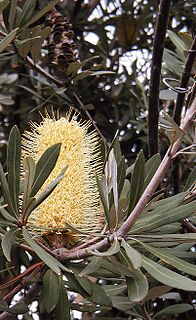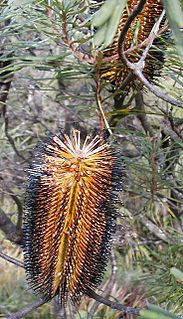
Banksia is a genus of around 170 species in the plant family Proteaceae. These Australian wildflowers and popular garden plants are easily recognised by their characteristic flower spikes, and fruiting "cones" and heads. Banksias range in size from prostrate woody shrubs to trees up to 30 metres tall. They are found in a wide variety of landscapes: sclerophyll forest, (occasionally) rainforest, shrubland, and some more arid landscapes, though not in Australia's deserts.

Banksia subg. Banksia is a valid botanic name for a subgenus of Banksia. As an autonym, it necessarily contains the type species of Banksia, B. serrata. Within this constraint, however, there have been various circumscriptions.

Banksia ericifolia, the heath-leaved banksia, or lantern banksia, is a species of woody shrub of the family Proteaceae native to Australia. It grows in two separate regions of Central and Northern New South Wales east of the Great Dividing Range. Well known for its orange or red autumn inflorescences, which contrast with its green fine-leaved heath-like foliage, it is a medium to large shrub that can reach 6 m (20 ft) high and wide, though is usually half that size. In exposed heathlands and coastal areas, it is more often 1–2 m (3.3–6.6 ft).

Banksia spinulosa, the hairpin banksia, is a species of woody shrub, of the genus Banksia in the family Proteaceae, native to eastern Australia. Widely distributed, it is found as an understorey plant in open dry forest or heathland from Victoria to northern Queensland, generally on sandstone though sometimes also clay soils. It generally grows as a small shrub to 2 metres (7 ft) in height, though can be a straggly tree to 6 metres (20 ft). It has long narrow leaves with inflorescences which can vary considerably in coloration; while the spikes are gold or less commonly yellowish, the emergent styles may be a wide range of colours – from black, purple, red, orange or yellow.

Banksia sect. Oncostylis is one of four sections of subgenus Banksia subg. Banksia. It contains those Banksia species with hooked pistils. All of the species in Oncostylis also exhibit a top-down sequence of flower anthesis, except for Banksia nutans which is bottom-up.

Banksia ser. Spicigerae is a taxonomic series in the genus Banksia. It consists of the seven species in section Oncostylis that have cylindrical inflorescences. These range in form from small shrubs to tall trees. The leaves grow in either an alternate or whorled pattern, with various shape forms. The Spicigerae inflorescence is held erect, subtended by a whorl of branchlets, and retains a regular pattern until anthesis. The perianth limb is horizontal until anthesis, at which point the perianth opens from underneath. The pollen-presenter is ovoid or conical. The seed wings are not notched.

Banksia integrifolia subsp. integrifolia is a subspecies of Banksia integrifolia.

Banksia integrifolia subsp. compar is a subspecies of Banksia integrifolia. It has larger, glossier leaves than other subspecies, and occurs much further north.

"The genus Banksia L.f. (Proteaceae)" is a 1981 monograph by Alex George on the taxonomy of the plant genus Banksia. Published by the Western Australian Herbarium as Nuytsia3(3), it presented George's taxonomic arrangement of Banksia, the first major taxonomic revision of the genus since George Bentham published his arrangement in Flora Australiensis in 1870.
This is a timeline of developments in knowledge and understanding of the Australian plant genus Banksia:

Banksia pteridifolia, commonly known as tangled honeypot, is a species of shrub that is endemic to the southwest of Western Australia. It has short, underground stems, deeply pinnatipartite leaves with sharply-pointed, linear lobes on the sides, creamy white or yellow flowers in heads of about one hundred and later up to five follicles in each head.
Kevin Thiele and Pauline Ladiges taxonomic arrangement of Banksia, published in 1996, was a novel taxonomic arrangement that was intended to align the taxonomy of Banksia more closely with the phylogeny that they had inferred from their cladistic analysis of the genus. It replaced Alex George's 1981 arrangement, but most aspects were not accepted by George, and it was soon replaced by a 1999 revision of George's arrangement. However some herbaria have continued to follow Thiele and Ladiges on some points.
Robert Brown's taxonomic arrangement of Banksia was published in his book of 1810, Prodromus Florae Novae Hollandiae et Insulae Van Diemen, and expanded in the supplement to that publication, Supplementum Primum Prodromi Florae Novae Hollandiae, in 1830. It was the first survey of Banksia species to be published, and included descriptions of a number of previously undescribed species.

Alex George's taxonomic arrangement of Banksia was the first modern-day arrangement for that genus. First published in 1981 in the classic monograph The genus Banksia L.f. (Proteaceae), it superseded the arrangement of George Bentham, which had stood for over a hundred years. It was overturned in 1996 by Kevin Thiele and Pauline Ladiges, but restored by George in 1999. A recent publication by Austin Mast and Kevin Thiele suggests that it will soon be overturned again.

Banksia spinulosa var. spinulosa is a shrub that grows along the east coast of Australia, in Queensland and New South Wales.

Banksia spinulosa var. cunninghamii, sometimes given species rank as Banksia cunninghamii, is a shrub that grows along the east coast of Australia, in Victoria and New South Wales. It is a fast-growing non-lignotuberous shrub or small tree infrequently cultivated.

Banksia laevigata subsp. fuscolutea is a subspecies of Banksia laevigata. It is native to the Southwest Botanical Province of Western Australia.
Banksia dallanneyi subsp. agricola is a subspecies of Banksia dallanneyi. It was known as Dryandra lindleyana subsp. agricola until 2007, when Austin Mast and Kevin Thiele sunk all Dryandra into Banksia. Since there was already a Banksia named Banksia lindleyana, Mast and Thiele had to choose a new specific epithet for D. lindleyana and hence for this subspecies of it. As with other members of Banksia ser. Dryandra, it is endemic to the South West Botanical Province of Western Australia.

Petrophile ericifolia is a species of flowering plant in the family Proteaceae and is endemic to southwestern Western Australia. It is a shrub with cylindrical leaves, and oval to spherical heads of hairy, yellow flowers.














